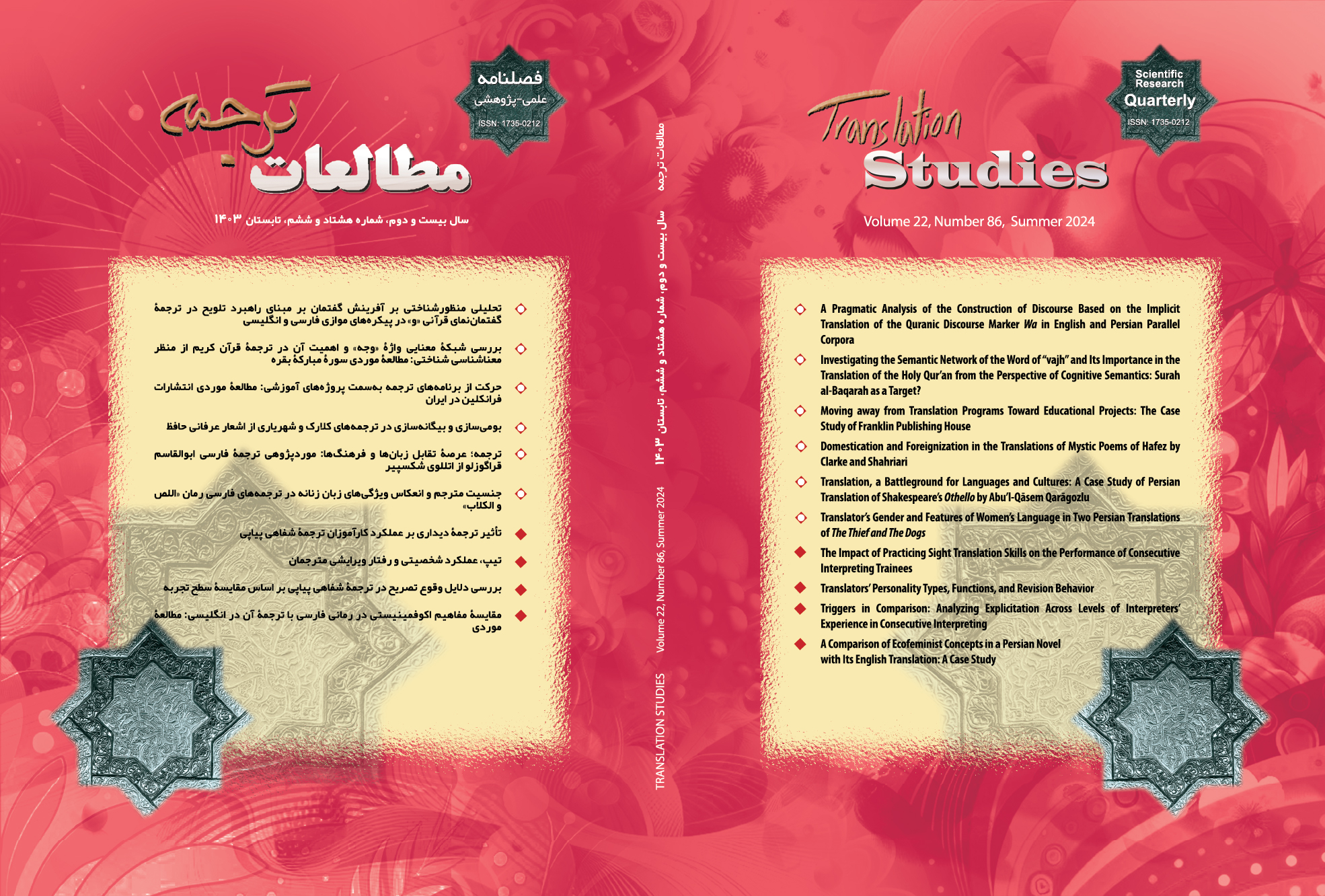Domestication and Foreignization in the Translations of Mystic Poems of Hafez by Clarke and Shahriari
Abstract
Hafez's mystic poems are among the most difficult to translate, because to fully understand them, you must be a Persian native speaker. The present article uses a descriptive-analytical method to examine some of Hafez's mystic poems translated into English by Clarke and Shahriari, to identify the tendencies of domestication and foreignization and the degree of visibility of the source text’s author in the target text. In this study, 14 samples of Hafez's mystic lyrical poems were randomly selected and analyzed in terms of domestication and foreignization methods for the two translations from which 5 poems have been discussed in this article. The findings show that both translators have used these two strategies, to a different extent. Shahriari's translation, which used the domestication method to a greater extent, seems more natural and more understandable for the target language reader (according to Nida). However, as much as fidelity to the source text is concerned, foreignization is more appropriate than domestication. In general, none of the localization and foreignization methods could fully transfer the main concept of the verses to the target text. Therefore, it is recommended to use footnotes in the translation to convey the full meaning and aesthetic taste in Hafez's poems.
Keywords:
Domestication, Footnote, Foreignization, Hafez's mystic poems, Literary translationReferences
اسلامی ندوشن، م. (1382). تأمل در حافظ: بررسی هفتاد و هفت غزل در ارتباط با تاریخ و فرهنگ ایران. یزدان.
برزگر خالقی، م. (1382). شاخ نبات حافظ: شرح غزلها همراه با مقدمه، تلفظ واژگان دشوار (جلد 29). زوار.
بشیری، ع. و محمدی، ا. (1397). میزان کارآمدی رهیافتهای لفور در ترجمۀ شعر بین زبان عربی و فارسی. جستارهای زبانی، 4(9)، 137–156.
بلوری، ک. (1391). رویکردی انتقادی به ترجمه انگلیسی هانری کلارک از اشعار حافظ: موردپژوهی. مطالعات ترجمه، 37، 89–98.
پوریاورچوبر، م. و. (1402). دو پهلوگویی و تداعی اندیشه¬های اجتماعی در غزلهای حافظ. تفسیر و تحلیل متون زبان و ادبیات فارسی (دهخدا کرج)، 58، 329–357. doi:https://doi.org/10.30495/dk.2022.1956299.247
حسینی معصوم، م. ه. (1394). تفاوتهای نحوی، چالشی در ترجمه ادبی (مورد پژوهی: ترجمه ضمیر سوم شخص مفرد در غزل¬های حافظ). فصلنامه مطالعات زبان و ترجمه، 2، 93–111.
رسولی، ح. و عباسعلی نژاد، م. (1394). تلقی ابراهیم أمین الشواربی و محمد الفراتی مِن الغزل الثامن الحافظ الشیرازی دراسة مقارنه. کاوش¬نامة ادبیات تطبیقی، 14، 99–114.
زارع بهتاش، ا. و فیروزکوهی، س. (1388). مطالعه در زمانی استراتژیهای غرابت زدایی و آشنازدایی مقولات فرهنگی مترجمان در ترجمه شش اثر ارنست همینگوی. دانشگاه دریانوردی و علوم دریایی چابهار.
سرپرست، ف. و. (1397). نقد و بررسی ترجمۀ شعر عرفانی با رویکرد نظریۀ لفور (بررسی موردی ترجمه محمد الفراتی از غزلیات حافظ) . پژوهشهای ترجمه در زبان و ادبیات عربی، 18، 39–66.
سلیمانی، ح. (1394). بررسی ترجمه کلارک از دیوان حافظ از نظر انتقال مفاهیم عرفانی. دانشگاه آزاد اسلامی واحد مرودشت.
عبدالرئوف، چ. (2019). ارزیابی انتقادی از نظریه بومی¬سازی و بیگانه¬سازی ترجمه ونوتی. مجله ترجمه و زبان، 18(1)، 72–82.
لفور، ا. (1977). ترجمه شعر: آسن. ون گورکوم.
ونفن، ی. (2010). بررسی مختصر بومی سازی و بیگانه¬سازی در ترجمه. مجله آموزش و پژوهش زبان، 1(1)، 67–80.
ونوتی، ل. (1991). تبارشناسی نظریه ترجمه: شلایرماخر. تی تی آر، 4(2)، 125–150. doi:https://doi.org/10.7202/037096ar
ونوتی، ل. (1995). ناپیدایی مترجم: تاریخچه ترجمه. روتلج.
ونوتی، ل. (1998). رسوایی¬های ترجمه: به سوی اخلاقیات تفاوت. نیوفتر.
Abderraouf, C. (2019). A critical evaluation of Venuti’s domestication and foreignization theory of translation. Revue de Traduction et Langues, 18(1), 72–82.
Lefevere, A. (1977). Translating poetry. Van Gorcum.
Venuti. (1995). The translator's invisibility: A history of translation. Routledge.
Venuti, L. (1991). Genealogies of translation theory: Schleiermacher. 4(2), 1215 doi: https://doi.org/10.7202/037096ar
Venuti, L. (1998). The scandals of translation: Towards an ethics of difference. New Fetter Lane.
Wenfen, Y. (2010). Brief study on domestication and foreigniztion in translation,. Journal of Language Teaching and Research, 1(1), 67–80.
Downloads
Published
How to Cite
Issue
Section
DOR
License
Copyright (c) 2024 Zahra Mahmoudabadi, Mahmud Vaez Maroofi, Fatemeh Takallou

This work is licensed under a Creative Commons Attribution-NonCommercial 4.0 International License.
Copyright Licensee: Iranian Journal of Translation Studies. This article is an open access article distributed under the terms and conditions of the Creative Commons Attribution–NonCommercial 4.0 International (CC BY-NC 4.0 license).





